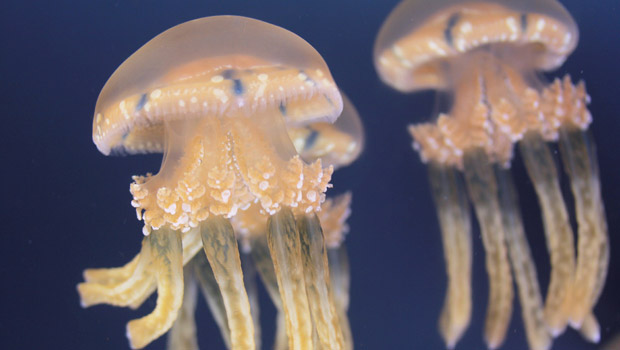Lagoon Jelly

The lagoon jelly (also known as jellyfish) belongs to the invertebrate Phylum Cnidaria, a diverse group of stinging animals whose members all possess stinging cells for feeding and protection. Jelly relatives include the sea anemones, corals, and Portuguese man-of-war. They are all simple, soft-bodied organisms with just two major tissue layers arranged around a central gut cavity. Individual animals are radially symmetrical, with a ring of tentacles around the central mouth. The tentacles bear stinging cells that are used for food capture and defense.
In the Cnidarians, there are two basic body forms the polyp form, like the familiar sea anemone, and the free-floating medusa form. Sea jellies, or jellyfish, illustrate the medusa body form: a gelatinous, bell-shaped body with mouth and tentacles hanging down from the undersurface of the bell. The jelly-like central layer of a medusa is 96% water, with protein and elastic fibers for gel and flex. Jellies are not attached to the bottom, but are carried by ocean currents, floating and swimming weakly by means of muscular contractions of the bell. However, the life cycle of most jellies includes a small polyp stage.
The lagoon jelly has a high, rounded bell that reaches diameters of 5 inches (12 cm). Using four frilly “mouth-arms,” it feeds on minute plankton and has only a mild sting. Small openings in the mouth-arms lead to the digestive cavity. Longer, club-shaped structures hang down below the mouth arms; these are not tentacles, but their function is uncertain. The animal’s brownish tint comes from symbiotic algae called zooxanthellae living within its tissues. The jelly receives some nutrition from the photosynthetic activity of the zooxanthellae and some species show distinctive light-seeking behaviors.
In Micronesia, this jelly is found in protected lagoons and salt-water lakes where it is sheltered from ocean swells by the reef or rocky island shore. In Hawai‘i, this species is found in quiet bays and harbors and is probably an introduction from other parts of the tropical Pacific.
Quick Facts
Scientific names
Mastigias sp.
Distribution
Indo-Pacific, including Hawai’i
Size
to 5 inches (12 cm) in diameter
Diet
microplankton, nutrients from symbiotic algae
Support the Aquarium
Contact Us
Honolulu, HI 96815
(808) 923-9741
Search
- Already a Volunteer?
- Click Here To Sign In


 Donate
Donate
